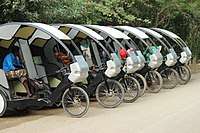Electric rickshaw
Electric rickshaws (also known as electric tuk-tuks[1] or e-rickshaws[2] or toto[3]) have been becoming more popular in some cities since 2008 as an alternative to auto rickshaws and pulled rickshaws because of their low fuel cost, and less human effort compared to pulled rickshaws. They are being widely accepted as an alternative to petrol/diesel/CNG auto rickshaws. They are 3 wheelers pulled by an electric motor ranging from 650-1400 Watts. They are mostly manufactured in India and China, only a few other countries manufacture these vehicles.[4][5] Battery-run rickshaws could be a low-emitter complementary transport for the low-income people, who suffer most from a lack of transport facility, if introduced in a systematic manner according to experts.[6]
Evolution of electric vehicles
The electric automobile did not easily develop into a viable means of transportation. Research waned from 1920-1960 until environmental issues of pollution and diminishing natural resources reawakened the need of a more environmentally friendly means of transportation. Technologies that support a reliable battery and the weight of the needed number of batteries elevated the price of making an electric vehicle.[7] In 1837, Robert Davidson of Scotland appears to have been the builder of the first electric car, but it wasn't until the 1890s that electric cars were manufactured and sold in Europe and America. During the late 1890s, United States roads were populated by more electric automobiles than those with internal combustion engines.[7][8]
Development of E-Rickshaw Market in India
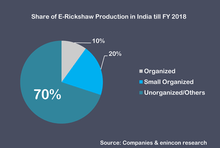
Share of E-Rickshaw Production in India[9]
E-Rickshaw's have now transitioned from being a market entrant in the automobile segment of the country to evolve as a leading short distance transport solution.
This segment has gained spurt in last 3 years and the growth has been phenomenal. Although, this segment is dominated by a host of unorganized players the established names have also identified the growth beacon and are expected to foray into the segment.
The share of production for e-rickshaws for now is indicated.
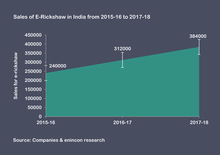
Sales of E-Rickshaw Trends in India[10]
E-Rickshaw has gained market base post 2015 in an established way.
Though introduction in India did happened on the lines of China in late 2010s but was very sporadic and was not spread across. It was the drive to have greener transport industry especially in tier-2 & tier -3 cities the e-rickshaw market is vastly gaining base and is likely to grip on further in coming years with the advent of established players in the segment as well. The actual sales value for e-rickshaws in India is depicted in Exhibit.
Design and construction
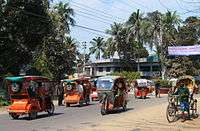
These rickshaws have a M.S(Mild Steel) tubular Chassis, consist of 3 wheels with a differential mechanism at rear wheels. The motor is brushless DC motor manufactured mostly in India and China. The electrical system used in Indian version is 48V and Bangladesh is 60V. The body design from most popular Chinese version is of very thin iron or aluminum sheets. Vehicles made in fiber are also popular because of their strength and durability, resulting in low maintenance, especially in India. Body design is varied from load carriers, passenger vehicles with no roof, to full body with windshield for drivers comfort[11] It consist of a controller unit.They are sold on the basis of voltage supplied and current output, also the number of mosfet(metal oxide field effect transistor) used. The battery used is mostly lead acid battery with life of 6–12 months. Deep cycle batteries designed for electric vehicles are rarely used. Weight of the electric car has also been a recurring design difficulty in them.[11]
Types
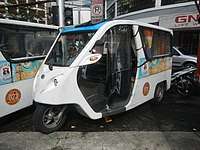
Load carriers
These are load carrying versions of these rickshaws differ in their upper body, load carrying capacity, motor power, controller and other structural aspects, sometimes motor power is also increased in order to carry loads up to 500–1000 kg.
Solar
There are two types of solar vehicles:
- Directly solar-powered - fitted with solar panels. A directly solar-powered rickshaw is an electric auto rickshaw driven solely by one or more electric motors, powered by solar panels mounted on the vehicle and capable of operating while the vehicle is in motion. Theoretically, solar panels could provide power directly to the motor(s) without the need for batteries, but in reality this would be an improbable design choice for a rickshaw, given its intended purpose. In e-rickshaws, however solar panels are not effective and are not frequently used.
In practice, the term solar rickshaw is most commonly used to describe battery-electric rickshaws whose batteries are indirectly solar-charged (i.e. independently from the vehicle) prior to use. This is usually facilitated by removing batteries in need of charging from the vehicle, and exchanging them for batteries which have already been charged. Alternatively, batteries can be charged in-situ while the vehicle is parked, although this may limit daytime usage. The exact same battery replacement and in-situ methods are of course also used for non-'solar' batteries and vehicles.[12]
Popularity
Electric rickshaw are most popular in Asia. The low cost Chinese version being the first to show up on streets. They are mostly used in China, India, Bangladesh and Nepal, also in low numbers other parts of Asia they have been showing up. China, Japan, India, and European countries (Switzerland, France, Germany) have researched and developed electric tricycles for commercial transport and are attempting to capture the growing market in Asia. Government has made efforts though to run them and made plans to issue licences on a fee of 1.5tk but there has been no action on this matter to date.[6]
Bangladesh
Bangladesh imports electric rickshaws directly from China or via other countries, the well established cities prefer them as cheaper and better means of transport. The government in an inter-ministerial meeting on May 5 banned import and assembly of the vehicles and decided to send off-road those already plying, primarily on the ground that it consumes electricity mostly through illegal connections.[6]
China
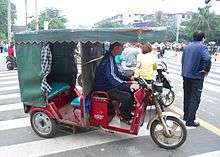
China is the largest manufacturer of electric rickshaws in the world, due to low labor cost, high production rates and encouraging government policies on foreign trade they import a large number on daily basis. There are hundreds of electric rickshaw manufacturers and thousands of parts producers. Their main market is within small towns or cities with insufficient public transport.[5]
India
One of the first attempt to design electric rickshaws was done by Nimbkar Agricultural Research Institute in late 1990s.[13] [14]. In India, these so-called e-rickshaws are widely spread all over the country, starting to gain popularity around 2011. The design is now much different from cycle rickshaws.
Today, e-rickshaws play a vital role in providing livelihood to people in India. Due to their low cost and high efficiency they are accepted on the Indian streets,[15] but government policies have been threatening the e-rickshaw and banned its use in the capital city Delhi,[15][16] but failed to put them off the streets. E-rickshaws are still rising in number and widely used in Delhi and other parts of India. In Delhi, as per government official's figures in April 2012, their number was over 100,000.[5][17]
Manufacturers often market their product as an Indian make, even though almost all vehicles are assembled from parts that were imported from China. This is due to the drastically lower cost of Chinese components, especially batteries and electronics.[4][17]
A downside of electric rickshaws in India is the predominant use of cheap batteries with low durability. As there is not the necessary recycling infrastructure in many parts of the country, the toxic chemicals in lead batteries lead to a waste problem.[5]
E-rickshaw law in India
Initially e-rickshaws were unregulated by any central law in India. However, the Delhi High Court, banned running of e-rickshaws in Delhi on 31 July 2014, over safety concerns raised through a public interest litigation.[18] In a rally held for regularization of e rickshaws in Delhi transport minister Nitin Gadkari said that "municipal corporations would regularize e-rickshaws by registering them for a fee of just ₹100. After registering the e-rickshaw, corporations will have to issue identity cards to drivers so they can earn their livelihood easily."[19] Once the policy was in place, the corporation, along with traffic police, would have fix the amount of fine to be imposed for violation of the policy.[19] However, the policy was never implemented. Certain states like Tripura had regularised the e-rickshaws through municipal bylaws or through state legislation.[18] In March 2015, the Indian Parliament passed an amendment to the Motor Vehicles (Amendment) Bill, 2015 legalizing e-rickshaws.[20] By July 2015, battery rickshaws are available for travel in many cities, now certified to ply with Registration No. plate by R.T.O. with insurance.
References
- "Tripura to register battery-operated rickshaws". Zee News. 25 June 2014. Retrieved 18 September 2014.
- Mohammad, Anas (21 October 2014). "Meet Tabassum Bano - the first female e-rickshaw driver of Allahabad". I am in DNA of India. Allahabad. Archived from the original on 29 October 2014. Retrieved 20 October 2014.
- "'Invention of Toto a stellar achievement' - Times of India". The Times of India. Retrieved 2019-03-25.
- "It's cheaper: Dealers import rickshaw parts from China, assemble them here". 20 March 2014. Retrieved 10 December 2016.
- Jamil, Faiz JamilFaiz. "Regulation threatens India's e-rickshaws". Retrieved 10 December 2016.
- "Electric rickshaws run out of steam". 30 May 2011. Retrieved 10 December 2016.
- Whitener, Barbara. The Electric Car Book. Louisville, KY: Love Street Books, 1981.
- Shacket, Sheldon R. The Complete Book of Electric Vehicles. Northbrook, IL: Domus Books, 1979.
- "2 & 3 Wheeler Electric Vehicle Market in India & Future Outlook 2022". Enincon.
- "2 & 3 Wheeler Electric Vehicle Market in India and Future Outlook 2022 Report Flyer" (PDF). Enincon.
- "How electric automobile is made - material, manufacture, making, history, used, parts, components, steps, product". Retrieved 10 December 2016.
- "Greenuadimfrom". greenuadimfrom.ml. Retrieved 2019-05-31.
- "Electric cycle rickshaws as a sustainable transport system" (PDF).
- "#Innovation: These Amazing Modified Cycle Rickshaws Are Making The Task Easier For Rickshaw Pullers". December 18, 2014.
- Bose, Pratim Ranjan (14 February 2014). "Cheap rides, low costs: it's Tuk-Tuk time in Tripura". Retrieved 10 December 2016.
- "Govt stops sale of e-rickshaws - Indian Express". Retrieved 10 December 2016.
- Mehta, By Nikita (6 February 2014). "Industry". Retrieved 10 December 2016.
- Harding, Simon; Rojesh, Seram (31 August 2014). "Battery Rickshaws in New Delhi and the Regulation Conundrum". Economic and Political Weekly. XLIX (35). Retrieved 15 September 2014.
- "Municipal corporations to frame policy on e-rickshaws in a month's time". Retrieved 10 December 2016.
- "E-Rickshaw Bill Passed". 10 March 2015. Retrieved 10 December 2016.
- Shacket, Sheldon R. The Complete Book of Electric Vehicles. Northbrook, IL: Domus Books, 1979.
- Whitener, Barbara. The Electric Car Book. Louisville, KY: Love Street Books, 1981.
- Regulation threatens India's e-rickshaws
- Govt stops sale of e-rickshaws - Indian Express
- Electric rickshaws run out of steam
- It’s cheaper: Dealers import rickshaw parts from China, assemble them here
- Delhi Auto Expo: India chases electric mobility dream
- Cheap rides, low costs: it’s Tuk-Tuk time in Tripura
- How electric automobile is made - material, manufacture, making, history, used, parts, components, steps, product
- Municipal corporations to frame policy on e-rickshaws in a month's time
